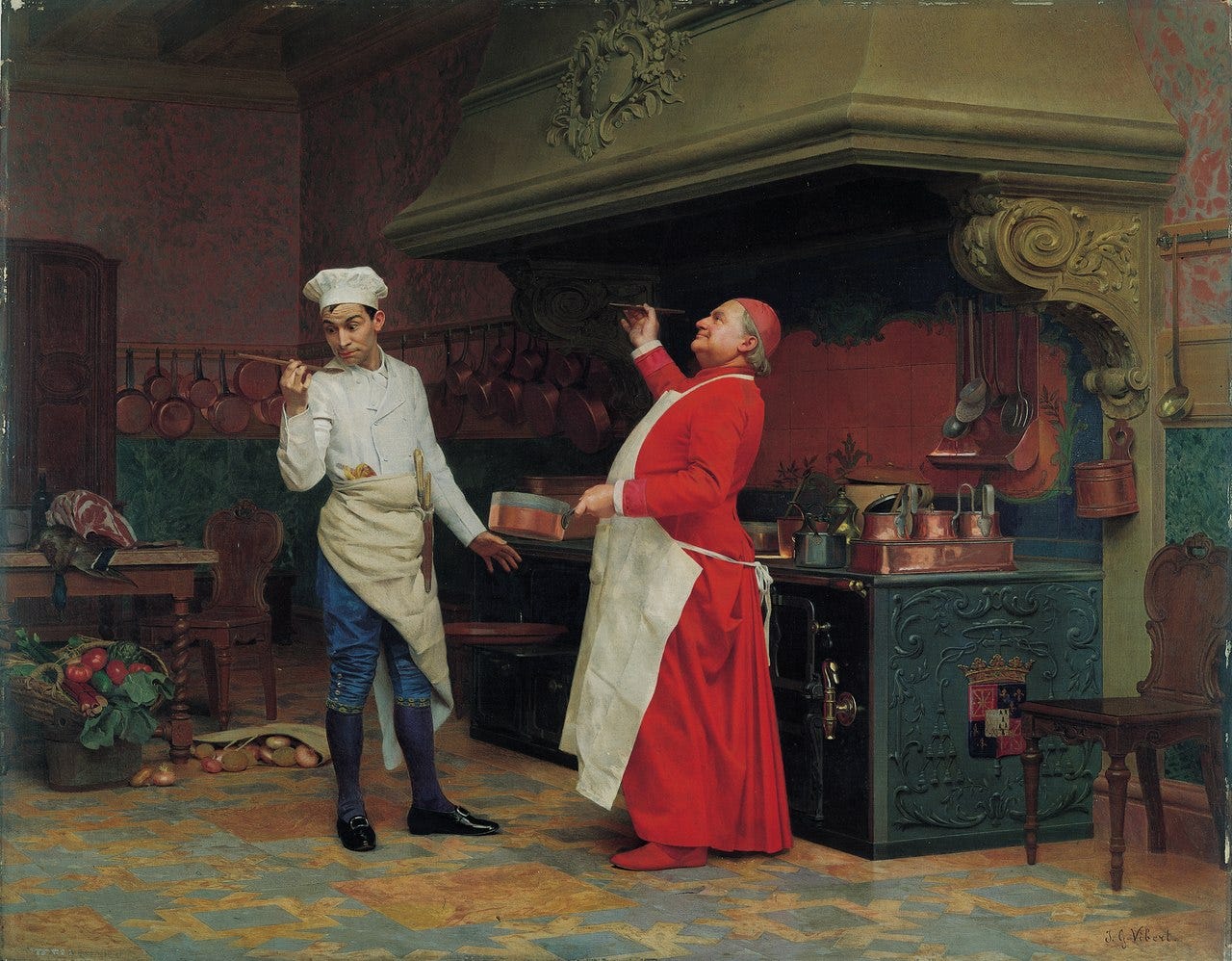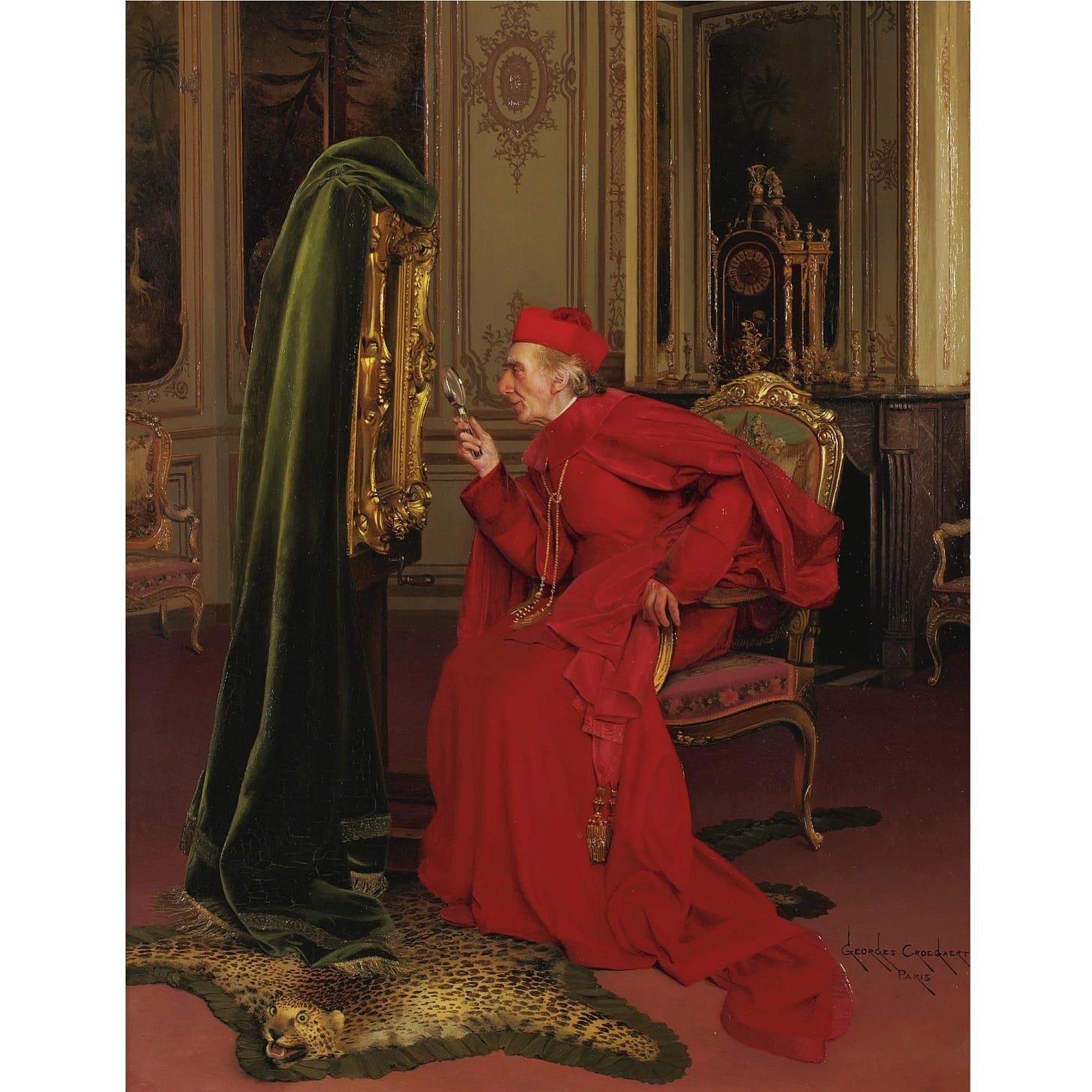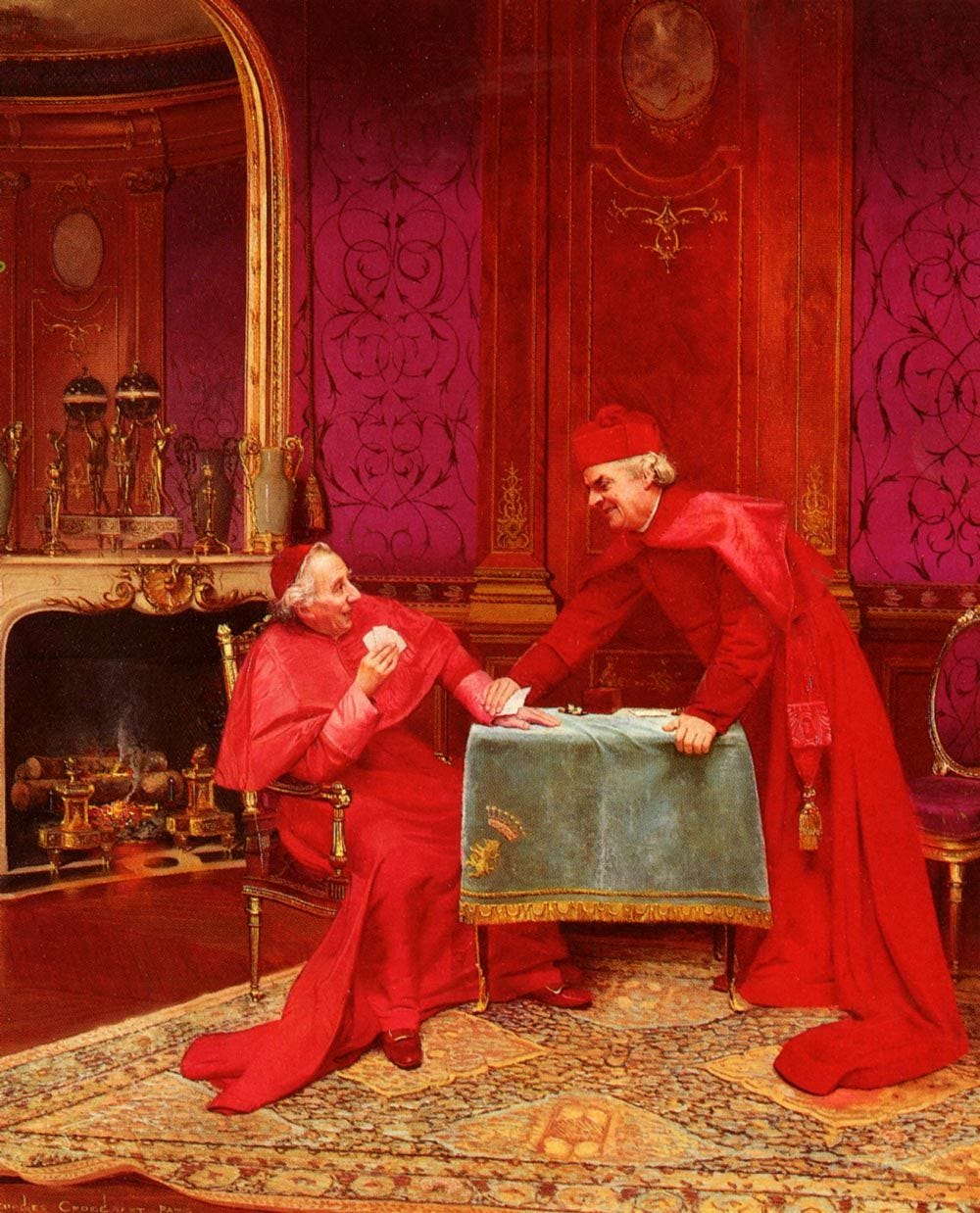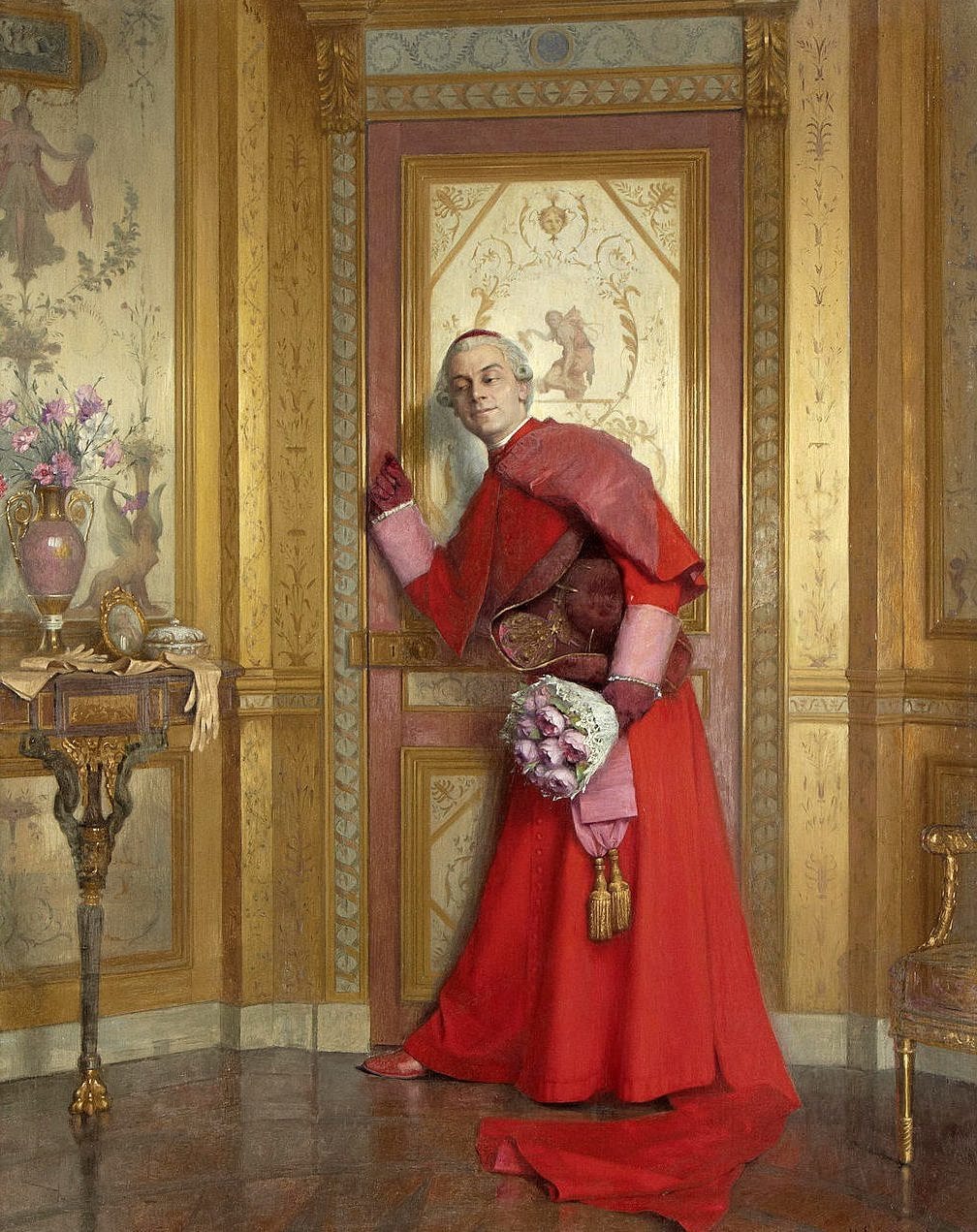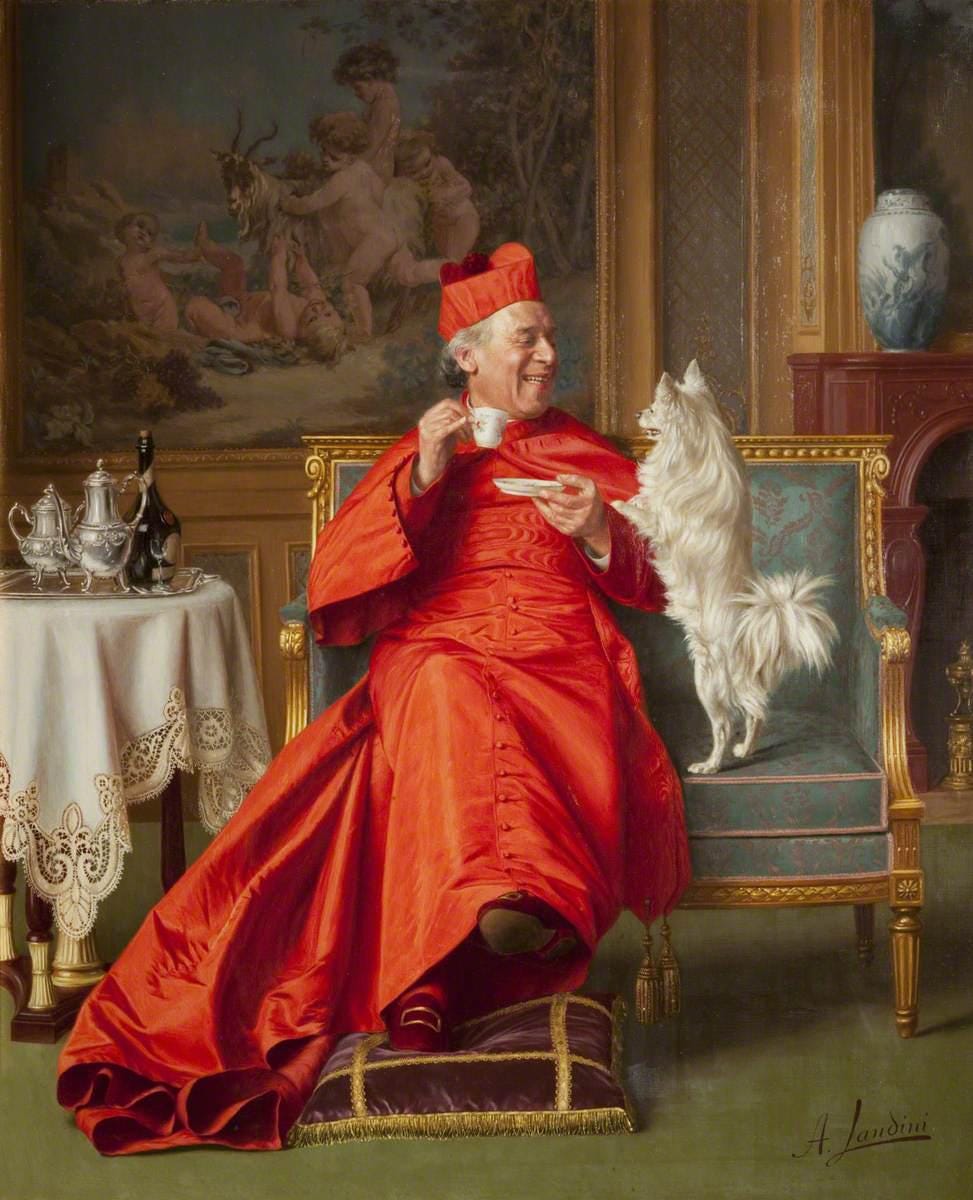On May 7th the doors will close. The last cassock will vanish through the gates. We’ll squint at the chimney, willing it to tell us something and then, the release we’ve all been waiting for, Habemus Papam! We are no longer a world of spiritual orphans.
What we see now is solemnity, bowed heads, whispered prayers, grand talk of humility and service. But history tells a messier story. Conclaves have seen fistfights, bribery, ghostly pranks, even cardinals locked in, starved, and stripped of their dignity. In 1655, a group of young cardinals, bored by weeks of deadlock, decided to liven things up. One dressed as the Holy Ghost and crept through the chapel at night, scaring an older cardinal so badly he collapsed.
So yes, they pray. But they also bicker, bluff, scheme and sometimes drop dead before the white smoke even curls. They are, quite obviously, just men in silk dresses playing world politics, nothing divine about it, all too human. They bleed when you prick them, giggle when you tickle them, and are as susceptible to earthly sins as you and me.
One of my favorite paintings of all time captures this delicious contradiction. Jehan-Georges Vibert's The Committee on Moral Books (1866). Two clerics, tasked with banning immoral literature, can’t help but sneak a peek at the very books they're meant to condemn. Their faces, teetering between stern disapproval and barely contained delight, say everything. It’s hypocrisy, painted with such sly precision you can almost hear the giggles behind the door. Even these, the so-called best of men, are just boys playing grown-up games.
A catalogue of clerical cravings
And with that, an entire subgenre of 19th-century European art opened up for me.
The paintings were plentiful, and the delights these clergy indulged in could be neatly sorted into their own taxonomy. So step aside, sins and virtues, here come the five earthly delights, according to the artists who knew them best.
Feasting and Drinking
Take Jehan-Georges Vibert’s The Marvelous Sauce (1880)
Here, a plump cardinal, apron straining over his generous stomach, stirs a bubbling pot with the devotion of a monk at prayer. His face beams not with divine inspiration, but culinary pride. Around him, pots gleam, and in the background heaps of produce and glistening cuts of meat pile up like offerings to some gastronomic god. This is no mere kitchen, it is a temple of gluttony. You can almost smell the beurre noisette and hear Julia Child in the background.
Appreciating (and Ogling) Art
In Georges Croegaert’s The art critic (ca 1900) is one of many small works in which cardinals are shown appreciating the, ahem, finer things. We see a red-robed cleric, leaning in to scrutinize a portrait that’s almost certainly not of a Madonna and Child. More likely, it’s a voluptuous young woman. Why else would there be a heavy cloth conveniently positioned to cover it at a moment’s notice?
His expression is pure academic inquiry. His thoughts, clearly, are not. The thick carpets, animal skins, the golden frames, the heavy velvet drapes, every detail conspires to show a man as devoted to earthly beauty as to heavenly matters.
Games and Leisure
Across dozens of canvases, cardinals play chess, pet tiny dogs, collect stamps, and lean in to inspect miniature mechanical toys with the glee of overgrown children. And then there's Georges Croegaert’s The Winning Hand (ca 1900). Two cardinals are mid-game, locked in a moment of triumph and disbelief. One, seated and holding the final card, is flushed with glee, his mouth mid-sentence, mid-gloat. The other leans forward in mock outrage, hand on the table, face twisted in theatrical protest. You can almost hear the cursing, the accusations of cheating, the barked laughter bouncing off the velvet walls. It's a frozen frame of pure clerical chaos, captured in satin and smirk.
Aspirations of Power
Then there’s Vibert’s If I Were King (ca 1860) a cardinal draped across Napoleon's abandoned throne, crimson robes pooling like spilled wine over imperial velvet. His posture is casual, but his eyes betray something hungrier. The suggestion is not just clear, it’s blazing. Under the cassock is a man who doesn’t dream of sainthood, but of rule. It’s a portrait of ambition barely dressed as piety, a glimpse of the crown-lust hiding behind the crucifix.
Forbidden Company
Perhaps the most tantalizing of all is Henri Adolphe Laissement’s An Unexpected Visitor or Marie Antoinette’s Antechamber (1921). A cardinal, mid-recline with a bouquet of flowers in hand, stands at the threshold of what appears to be Marie Antoinette’s lavish antechamber, a setting that only deepens the absurdity. Maybe he is unexpected, though perhaps not entirely unwelcome. His face flickers with anticipation and delight, the look of someone caught between thrill and scandal. The lush textures of the room, the charged intimacy of scene, it all hints at a truth the Church has long tried to keep tucked away. Celibacy, after all, has always left a little space for imagination. And sometimes, for visitors.
Enter the secret museum of velvet sins
These paintings weren’t only an attack on the Church. They were a toast to humanity, greedy, silly, brilliant humanity. They reminded us, quietly but clearly, that even the most exalted robes hide ordinary cravings. A good meal. A stolen glance. A well-played card.
There’s something almost cinematic in the way these clerics are caught. Their faces are elastic, their gestures theatrical. Watching them is like watching a Louis de Funès film: the raised eyebrows, the tiny scandals, the slapstick masquerading as solemnity.
Jacques Dynam et Louis de Funès in Fantomas se déchaîne.
They came at a moment when the Church was losing its monopoly on truth. Liberalism and secularism were gaining traction. Artists picked up their brushes and painted that vibe. Hanging one of these in your cigar room wasn’t just for laughs. It was a quiet rebellion, gilded and smirking.
So as the smoke rises and the world watches Rome with reverent awe, remember, beneath those scarlet robes might still beat the heart of a man who’s not above a little sauce.
Encore:
And if this genre has taught me anything, it’s that the game is far from over. The paintings are plenty. The mischief is eternal. I invite you to continue the hunt, you might enjoy it as much as I did.
Start with these names: Jehan-Georges Vibert, Francesco Brunery, Marcel Brunery, Georges Croegaert, Andrea Landini, Charles Édouard Delort, Adolphe Henri Laissement, Jules Benoit-Lévy, Eduardo Zamacois y Zabala, and Victor Marais-Milton.
They built a secret museum of velvet sins. All you have to do is open the door. You’re welcome.
Andrea Landini - The impatient (ca 1870s)




